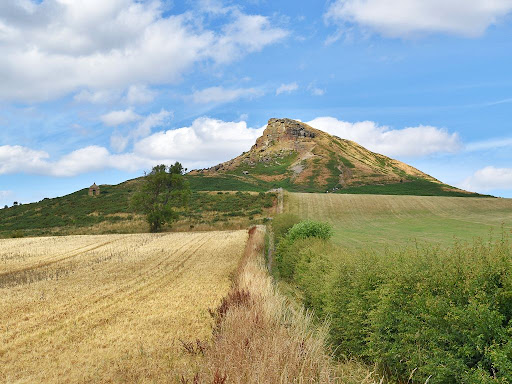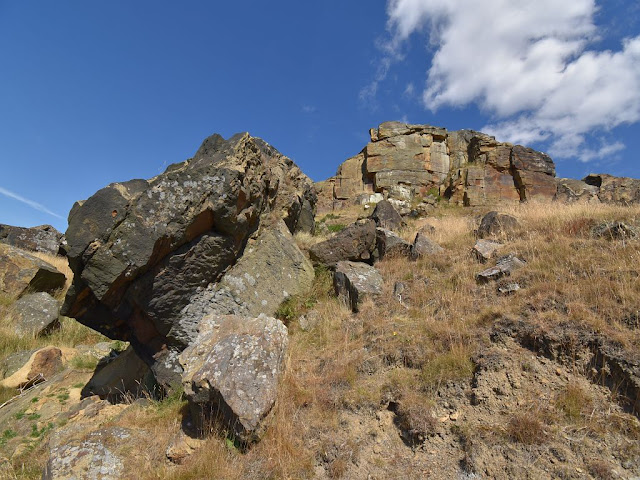Even a brief look into the history and folklore of Roseberry Topping reveals a fascinating picture of this impressive local landmark. One interesting source of information is the 'Chaloner letter' written in early 1660's, which mentions Roseberry Topping, and noted that ...
"it hath somtymes had an hermitage on it, and a small smith's forge cut out of the rocke, together with a clefte or cut in the rocke called St. Winifrid's Needle, whither blind devotion led many a silly soul, not without hazard of a breaknecke tumblinge caste, while they attempted to put themselves to a needless pain creeping through that needle's eye."(Nichols, 1853)
The presence of a hermitage, and the 'blind devotion' of 'many silly souls' crawling beneath a rock dedicated to Saint Winifrid, points to this hill top having once being a religious site visited by pilgrims before the Reformation. There are no signs of the hermitage or other features on the hill top today, except perhaps for a rectangular section cut out of the rock near the modern trig point. This appears to be a much worn floor surface, and may be all that survives of the hermitage (or forge?). What became of Saint Winifrid's Needle is also unknown, it may have been destroyed after the Reformation, or by later quarrying. Another possibility is that the cleft was part of the cliff edge which collapsed after a massive lands slip in 1912. The Chaloner letter notes that there was a danger of people falling to their deaths as they crawled through the 'Needle's Eye', which suggests that it was on the edge of the crag high up on the hill.

|
|
Remains of the Hermitage? |
Today, a large number of initials and dates can be seen carved into the rock surfaces on the hill top, and it appears that these carvings were also present on the section of the cliff edge that fell away. A search amongst the broken and tumbled boulders below the crag found several examples of dates and initials, which predate the rock fall, and so were originally part of the cliff top above. There was a hope whilst searching amongst the rocks, that as the hill appears to have once been a religious site, there might be carvings or 'historic graffiti' relating to this.
One of the largest blocks of stone to have fallen from the crags proved interesting in this respect. Its worn upper surface has many initials carved on it, suggesting that it was part of the top surface on the original cliff edge before it fell. However, below this top surface, on the vertical side of the block, there is a section of what appears to be much older style lettering and markings. The soot blackened face of this rock indicates which side faced out from the crag, and as the main section of older carvings are not blackened, this suggests that the side of the rock was sheltered in some way - perhaps in a cleft or crevice between the rocks on the cliff top. If this was the case, the cleft would form a passage leading out to the cliff face with a sheer drop at the end, while the carvings would be on the side wall of the passage.

|
| Double V top left, heart and 16xx lower left, 1773 centre 1596(?) lower right |
Many of the carvings on the hill top take the form of initials and dates, for example "T.D. 1854", and these are often made with chisel type tools. In contrast, most of the carvings on this fallen rock appear to be scratched or scraped with a knife or similar, and comprise of single letters or initials, but very few dates. The style of lettering seems to date from the 1600 or 1700's, and on one part of the rock, this old lettering looks almost Runic. The carvings continue along the side of the rock with another flat surface almost covered in letters and initial, along with other fainter lines scratched in between them. This whole series of carvings gives the impression that many people wanted to leave their mark on the side of this rock for some reason.
What is also interesting to note is that amongst all the lettering there are a number of symbols cut into the rock, including small crosses, diamonds, and VV marks. The double V is known as a Marian mark, and they are quite commonly found scratched into the walls of old churches. Marian marks are connected with the veneration of the Virgin Mary, with the VV thought to stand for Virgo Virginum (Virgin of Virgins). In some cases the VV is found inverted to form the letter M, also thought to stand for Mary or Madonna. These markings were carved in churches to invoke the blessing and protection of Saint Mary, and as there were usually 'unofficial' marks, they are referred to as historic graffiti.

|
|
Crosses, double V, and diamond symbols |
The small crosses, Marian marks, and other symbols suggests that this rock had some religious significance when it was on the cliff edge on top of the hill. A search of the other rocks on and around the hill found nothing similar to the carved surfaces on the side of this fallen block, so they do appear to be unique to this rock. From its shape and original position on the hill top, it is quite possible that it formed part of the cleft in the rock known as Saint Winifrid's Needle. The overhang above the carved surface on the side of the block may have narrowed the top of the cleft to form the 'Needle's Eye' opening, part way along the passage. The "many silly souls" (pilgrims?) would then have crawled along the cleft and through the Needle's Eye to the end of the passage at the cliff face. At this point there would be a real risk of a "breaknecke tumblinge" down the cliff face as they either turned around to crawl back or climbed up out of the cleft.

|
|
Over hang above the carvings on the side of the rock. |
It was perhaps these religious visitors who carved some of the symbols, letters, and initials on the side of this rock - leaving their mark to show that they had made the pilgrimage and performed their religious devotions. The scratched outline of shoes can also be seen on the top surface of this rock, and these are thought to be another type of pilgrim mark. After the Reformation, the Catholic faith was officially banned, along with pilgrimages to holy sites. However these continued in secret, especially at isolated locations, which could explain the continued use of this site.
Less than a mile to the south west of Roseberry Topping, an old chapel and holy well dedicated to Saint Oswald used to stand alongside a track leading up the hill. This may have been the starting point for pilgrims on their way up to the hermitage and Saint Winifrid's Needle. There was also a spring with healing properties near the top of the hill, which was probably a holy well before the Reformation.
It should perhaps be no surprise to find that this impressive peak and local landmark was regarded as a holy hill in Christian times, as its older name - Othenesberg ( Odin's mountain) points to it also being an important religious site for the early Scandinavian settlers in this region. The Needle's Eye rock may even have been the focus of their religious activity too - but that is a speculation for another time (see Rosebery Topping - the high altar of Odin?)
After Notes
Although the Chaloner letter records the cleft in the rock as being
dedicated to the Welsh female saint Winifrid, later writers assumed this was
an error, and that it was really Saint Wilfrid, perhaps due to there being a
St. Wilfrid's Needle at Ripon cathedral. However the Needle's Eye at Ripon
seems to have also been widely known as St. Winifrid's Needle in the past. It
is worth noting that Winifride became a virgin martyr when she rejected the
advances of a Welsh prince, who then cut off her head. So the VV symbol (holy
virgin) may have also been associated with Saint Winifride as well.
Folklore practices involving passing through holes or gaps in rocks are usually associated with fertility beliefs. The Marian marks on the rock may be connected with this, as Mary is the archetypal Mother, possessing knowledge of the mysteries of conception and child birth without pain.
The upper part of this rock is made up of an iron rich stone, and where the surface is broken this reveals a strong red ochre colour. This colouring may have been seen as significant, and it is possible that some of these pieces were broken off deliberately to take away.
Reference
Nichols, J.G. 1853. The Topographer and Genealogist Vol 2





Post a Comment